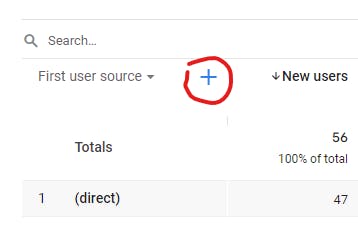Enhance Your Coverage with Secondary Dimension in Google Analytics
Enhance Your Coverage with Secondary Dimension in Google Analytics
Blog Article
Unlock Deeper Insights With Second Measurement in Google Analytics
With the huge area of data readily available in Google Analytics, the usage of additional dimensions can dramatically enhance your analytical capacities. These extra layers of information offer a nuanced perspective that can light up complex information within your primary metrics. By strategically including second dimensions into your analysis, you can unearth important understandings that could or else remain undiscovered. The capacity to dissect and translate user actions with better precision opens up a world of opportunities for enhancing strategies and boosting efficiency.
Understanding Key Vs. Second Measurements
On the other hand, additional measurements allow you to further study your primary measurement information. By including a second dimension, you can layer on added info to your key dimension, making it possible for a more granular analysis. If your primary dimension is the source/medium with which users got here on your site, adding a second measurement like geographical area can disclose where those individuals are situated geographically.
Making Use Of Secondary Measurements Properly
Successfully utilizing additional measurements in Google Analytics improves the depth and granularity of data evaluation, supplying useful insights right into user behavior and fads. By including second measurements together with main measurements, online marketers and analysts can delve much deeper right into the specifics of individual communications on their internet sites. Secondary measurements enable individuals to segment and filter primary dimension data better, using an extra thorough view of individual habits, demographics, and communications. This can be especially helpful when trying to comprehend the impact of specific variables on user involvement, such as the tools or browsers they are making use of, the sources of their traffic, or their geographical places.
Additionally, second measurements make it possible for individuals to contrast and contrast various data points within a solitary record, assisting in a much more extensive evaluation of customer actions patterns. By leveraging secondary dimensions efficiently, businesses can reveal surprise understandings, maximize their marketing techniques, and improve the general user experience on their websites.
Exploring Typical Secondary Dimension Mixes
To better evaluate individual behavior and fads in Google Analytics, it is important to check out common mixes of additional measurements. By incorporating various second dimensions, experts and marketers can obtain deeper insights right into exactly how various factors impact and connect internet site efficiency. Some common secondary dimension combinations that give beneficial understandings consist of evaluating traffic resources with customer places to recognize where internet site visitors are originating from geographically and how they located the site. Similarly, integrating landing pages with devices can expose which pages execute best on different tools, aiding in optimizing the web site for far better individual experience. In addition, checking out customer actions metrics with secondary measurements such as passions or demographics can aid in targeting details audience sectors more effectively. By checking out these common additional measurement mixes, businesses can discover covert patterns, identify opportunities for improvement, and make data-driven decisions to improve their online existence.
Using Secondary Measurement in Personalized Information
Utilizing additional dimensions in custom-made reports enables a more detailed evaluation of data in Google Analytics, boosting the depth of understandings gotten. When creating custom reports in Google Analytics, integrating additional measurements can give a much more detailed sight of how numerous measurements communicate with each other. This attribute allows customers to dive much deeper right into their data and uncover useful correlations that may not be promptly noticeable.
By applying additional measurements in custom-made reports, users can get a far better understanding of their website or application website traffic. For instance, incorporating the key dimension of "source/medium" with the second measurement of "touchdown page" can reveal which touchdown pages are carrying out ideal for website traffic coming from certain resources. This insight can assist online marketers maximize their campaigns and improve overall conversion rates.

Enhancing Information Visualization With Additional Dimension
When exploring data in Google Analytics custom records, integrating second measurements not just gives a much more detailed evaluation but additionally enhances the visual depiction of understandings via data visualization. By adding an additional measurement to your records, you can enhance the means data exists, making it less complicated to determine patterns, fads, and correlations within your internet site's performance metrics.
Second measurements can assist you segment your data better, permitting for a deeper understanding of customer actions and communications on your website. When trying to separate particular variables that may affect your website's performance., this improved level of granularity can be especially useful.

Verdict
In final thought, leveraging second dimensions in Google Analytics enables an extra detailed analysis of information, bring about much deeper insights and more informed decision-making. Secondary Dimension in Google Analytics. By adding added layers of details to main data collections, analysts and online marketers can discover surprise trends, patterns, and connections that give a granular sight of individual habits and communications. This improved degree of understanding allows optimization of campaigns and customized methods for view publisher site details target market sectors, eventually improving efficiency and conversion rates
On the various other hand, moved here additional measurements enable you to more dissect your primary dimension data. By adding a second measurement, you can layer on extra details to your main measurement, making it possible for a more granular evaluation. If your primary measurement is the source/medium via which users got here on your website, including a second measurement like geographic location can expose where those customers are located geographically. By integrating additional measurements along with key measurements, marketers and analysts can dig much deeper into the specifics of user interactions on their internet sites. Secondary measurements permit customers to sector and filter main measurement data better, providing an extra comprehensive view of individual demographics, habits, and interactions.
Report this page